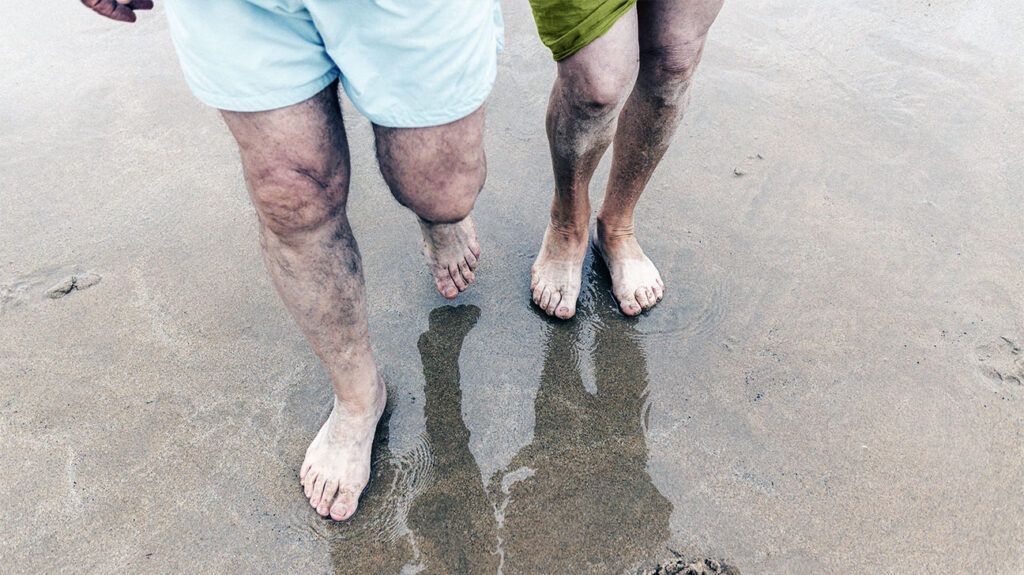Peripheral vascular disease is a lack of blood flow through the arteries, typically affecting the legs and feet. The main symptoms include pain, numbness, weakness in the legs and feet, skin discoloration, and slow wound healing.
Peripheral vascular disease (PVD) occurs due to a narrowing of the peripheral blood vessels that transport blood from the heart to the rest of the body. Another term for PVD is peripheral artery disease (PAD).
This article looks at the symptoms of PVD, the stages of the condition, and possible complications. It also discusses the typical outlook and when to contact a doctor.

PVD
PVD can also affect the upper extremities, including the fingers, hands, and arms. This is less common and affects around 10% of people with PVD.
Some people may not experience symptoms of PVD. Among those who do, the
- Pain or heaviness in legs: People may feel aching or cramping in their legs during exercise, which goes away with rest. The term for this is “claudication.” The pain may affect the calf, thigh, or buttocks.
- Weakness or numbness: This may affect a leg, which can cause difficulty walking and problems with balance.
- Reduced toenail or hair growth: Leg hair and toenails may stop growing.
- Temperature changes: People may have one foot that feels colder than the other.
- Skin discoloration: A leg or foot may be paler than usual, blue, or discolored.
- Pins and needles: People may feel pain, tingling, or pins and needles sensations in their foot or leg.
- Slow-healing wounds: Wounds or sores on the legs or feet may be slow to heal, or they may not heal at all, leading to infection.
In severe cases of PVD, people may experience pain in the foot or leg when resting. This is critical limb ischemia and is a severe restriction in blood flow.
Does PVD lead to gangrene?
Gangrene is tissue death that occurs due to a lack of blood flow or severe infection. Dry gangrene occurs due to a lack of blood flow to tissue.
If PVD progresses, it
Prompt treatment for gangrene is essential. The treatment aims to restore blood flow and prevent further tissue loss.
Treatment may include antiplatelet medications, which prevent blood clots from forming. Examples include aspirin and clopidogrel.
Read about treatment for PVD.
According to a 2018 article, doctors in the United States use the Rutherford classification system to stage PVD. The stages are as follows:
- Stage 0: no symptoms present
- Stage 1: mild claudication, in which people feel pain when exercising, but it goes away with rest
- Stage 2: moderate claudication
- Stage 3: severe claudication
- Stage 4: pain while resting
- Stage 5: ischemic ulcers, which are wounds due to poor blood flow
- Stage 6: severe ischemic ulcers or gangrene
PVD occurs due to plaque buildup in the arteries’ lining. This plaque narrows the blood vessels, restricting or blocking blood flow around the body.
- being age 65 years or over
- genetic predisposition or a family history of blood vessel disease, such as vasculitis, heart disease, or stroke
- smoking or frequent exposure to secondhand smoke
- lack of physical activity
- stress
- a diet high in saturated fats
- diabetes
- chronic kidney disease
- blood clotting disorders, such as thrombocytosis
- fibromuscular dysplasia, a condition that causes the arteries to narrow
- high blood pressure
- obesity
- metabolic syndrome
- high cholesterol or triglyceride levels
- preeclampsia or gestational diabetes during pregnancy
If people have symptoms of PVD, they will need to talk with a doctor. Without proper management, PVD
People can also talk with a doctor if they have risk factors for PVD and discuss steps for reducing their risk.
If people have signs of limb ischemia, they must seek medical help immediately. This includes:
- being unable to feel or move a foot
- leg or foot pain that does not go away with rest
- pins and needles when resting
- having one foot that is colder or paler than the other foot
People will need to call 911 or seek immediate medical attention if they have severe infection symptoms, including fever and chills.
Lifestyle changes and treatment
Without lifestyle changes and treatment, PVD
People with PVD will need to manage the condition
PVD is a lack of blood flow due to narrowed arteries. It usually affects the legs and feet but can also occur in the arms and hands.
Symptoms of PVD typically include pain, numbness, and tingling in the affected limbs. It may also include pain when exercising, which eases upon rest. Without treatment, PVD can progress and cause severe loss of blood flow.
PVD progresses through stages 0–6. Doctors diagnose end stage PVD, or stage 6, when a person has ischemic ulcers on the limb or develops gangrene.
Lifestyle changes and treatments can help people manage PVD and reduce the risk of complications.
